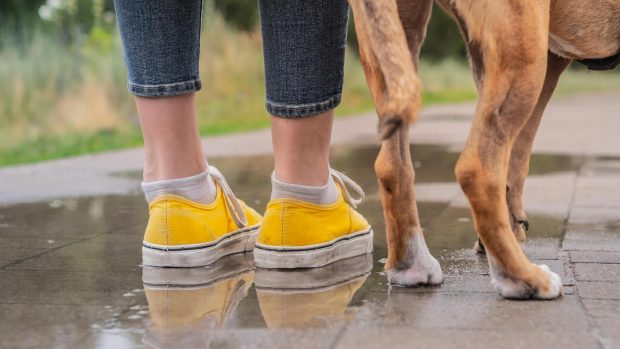Wanting to know how to stop a dog pulling on the lead is a very common desire among dog owners. You will have heard other dog owners saying that their dog is “much better off a lead and can be a nightmare on it”. And it’s not just the pulling, but the reactivity and lungeing that often comes with it.
I believe working a dog round the neck, with a traditional collar and lead (and especially choke chains, half checks and prong collars), should be a thing of the past, until such time it is two years old and has learnt not to pull or lunge on a lead. However, I believe the health implications will always outweigh the need to put a dog on a collar and lead – it’s preferable to avoid the collar and lead throughout your dog’s life if you can. By law, dogs must wear a collar and an ID tag in public places but that doesn’t mean it needs to be used as means for attaching a lead and walking.
There are some exceptions – gundogs and show dogs. Gundogs need to be quickly released and have nothing on them that may catch or trap them, while show dogs need to have their whole body and conformation on display in the ring. Outside of working or showing, however, there’s no reason the lead cannot be introduced in combination with other equipment and to reduce pulling kindly, without the worry of causing an injury and get them used to feeling a different kind of pressure on their body, such as their neck.
Why do dogs pull on the lead?
Dogs pull for a variety of reasons. Some pull because they are over excited, untrained and usually on the wrong diet, but many are uncomfortable or anxious. A slightly nervous dog or one that has been yanked about and hurt will begin to associate the pain and anxiety the feel on the collar or slip lead with what is coming towards them, be that a person or a person and a dog.
If you have a guarding breed, such as a German Shepherd or rottweiler, that pulls, this puts you in a retreat position where you’re pulling backwards. This signals that you’re unsure and backing off, which will cause them to guard more and lunge forward.
If all these things happens in the formative part of a dog’s life – especially during a puppy fear period – they will have learnt negative associations with being on a lead and seeing other people and dogs, which gives rise to the fight or flight instinct.
Health implications of pulling on the lead
There are several potential problems associated with dogs pulling on the lead, explains Valerie Freeman MRCVS, owner of Green Lane Veterinary Clinic in Headcorn, Kent.
- Bruising and pain can can cause a range of symptoms, including stiffness, inability to turn the head normally, crying or yelping especially when touched, being unwilling to move or walking very slowly and tentatively.
- Damage to the trachea (windpipe) due to the increased pressure when the dog is pulling, resulting in restricted air intake, which leads to choking and gasping. The dogs’ eyes may also become bloodshot with continued pressure.
- Nerve damage caused by increased pressure on the neck from a collar, which can lead to problems in the limbs.
- Eye problems can also be caused by nerve damage as there is a nerve running in the neck that innervates the eye and eyelids. Damage to this can cause Horner’s Syndrome, which is characterised by drooping eyelids, constricted pupil and/or a sunken eye. Brachycephalic breeds, such as French Bulldogs, are particularly prone to eye problems and have relatively small windpipes so lead pulling can increase the likelihood of severe problems.
- Orthopaedic injuries – the most extreme of which could be a fracture, for example, if the dog came to a sudden halt at the end of a retractable lead.
- Intervertebral disc herniation, which can occur because of trauma, including that from a collar, as well as from disc disease. When this happens, it can cause neurological symptoms ranging from pain to paralysis because of trauma to the spinal cord. Repeated trauma from regular pulling on a lead and collar will increase the chance of injury.
Is a harness better than a collar?
The short answer is yes, but there are a few types of dog harnesses that prevent pulling and some are better than others. I advise you use a front-loading harness and am in the process of developing my own one, but in the meantime the PetSafe Easy Walk Training Harness (which you can get on Amazon) is front-loading, as is the Halti Front Control Harness (also on Amazon).

Halti No-Pull Harness | Amazon.co.uk
This fully adjustable no-pull solution has both a no-pull lifting action and front control steering. It’s also a great option for flat-nosed breeds who can’t wear a headcollar.

PetSafe Training Harness | Amazon.co.uk
This padded front-loading harness minimises your dog’s pulling by gently steering him in the right. It safely controls light to moderate pulling by resting across your dog’s chest instead of his throat, preventing choking, gagging or coughing.

Halti Front Control Harness | Amazon.co.uk
This front-loading harness has two points of connection for extra control, benefits from neoprene padding and has five points of adjustment to get the perfect fit.
How to teach a dog to loose lead walk – and not pull on the lead
I use three methods when I teach lead walking – and I find these are all much easier on a front-loading harness. I incorporate all three of these during a lead training exercise and find it is only a couple of sessions before we have nice, relaxed loose lead walking dogs.
These methods can also be applied to head collars and back loading harnesses, but not to such good effect. Some trainers suggest stopping when they pull before moving off again, but I find this counterproductive as it takes forever to get anywhere – and it takes far longer for the dog to grasp and understand what is required as there are often no cue words used.
Squeeze and release
- Squeeze and release the lead to correct the pull. You can also move your arm back slightly until they are by your side.
- Walk in a normal manner while asking the dog to “with me” or heel” before releasing.
Lead around legs
- Place the lead around the back of your legs, so that it rests either in the knee crease or just above on your thighs.
- Gather up any excess lead and hold that arm straight down your side. For example, if you’re walking the dog on your left, the lead will be in your right hand, while your left hand is free. The natural movement of your walk checks and releases the lead behind you and teaches a close loose lead heel walk.
- You would only ever use the left hand if the dog tried to swap sides by going behind you, in which case your left hand would pick up the lead and bring the dog back round to the left side.
- Make sure the lead is not too long so that the dog can cut across you and trip you up, but not so short that the dog feels trapped and tries to go behind to avoid being trodden on.
Lead in both hands
- Hold the lead in both hands.
- If the dog begins pulling, draw your arms into your waist and put your weight onto your back leg. This makes the dog spin inwards without hurting them, as they are controlled from the chest, and it’s their own momentum of speed and power that makes them swing round against the harness.
- He should learn to make the right decision – and not pull – by himself.
Is there a difference between teaching an adult dog and a puppy?
Adult dogs and puppies can learn in the same way. I actually find that with older dogs – especially those who’ve been pulled around the neck – the minute the harness is on and the lead attached to the chest piece, the dog is calmer, more relaxed and will walk by your side with very little guidance.
With puppies, you’ll need to introduce the training slowly and over shorter periods of time. Avoid applying too much pressure on the lead if the puppy plants or flips about. Instead, get down in front of them and walk backwards using your fingers as a lure and a high value reward if necessary. This takes their mind off the new feeling and moves their brain forward from worry to work. Once moving and the lead has no tension, affirm by saying “yes” and walk on with the dog by your side again.
You might also be interested in:

These are the Amazon Prime Day dog deals 2024 we’d buy ourselves

No more tug of war: 6 of the best anti-pull harnesses for dogs

Seven of the best harnesses to help you and Fido enjoy your walks together

No more yapping: how to stop a dog nuisance barking

Reliable recall: the best whistles to train your dog

Why does my dog eat poop?

Subscribe to Horse & Hound magazine today – and enjoy unlimited website access all year round
Horse & Hound magazine, out every Thursday, is packed with all the latest news and reports, as well as interviews, specials, nostalgia, vet and training advice. Find how you can enjoy the magazine delivered to your door every week, plus options to upgrade your subscription to access our online service that brings you breaking news and reports as well as other benefits.





